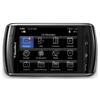Using the Storm
The Storm is a bit shorter and about as wide as the iPhone, but it's noticeably thicker -- .55 inches versus .48 inches for the iPhone. Still, the Storm felt comfortable in my admittedly large hand.
One lovely feature is its 3.25-in. screen. With 480-by-360 resolution, it has a somewhat sharper image than the iPhone's slightly larger 3.5-in. display with 480-by-320 resolution. Images, text -- everything, really -- displayed beautifully.
Because it relies entirely on touch-screen navigation, the Storm is very different from its predecessors; it doesn't have a physical keyboard, a side-scroll wheel or a navigation button on the front. As a result, longtime BlackBerry users have to get used to the Storm. But that shouldn't require much time -- this device is easy to use.
It's impossible, of course, to review the Storm without making comparisons to the iPhone. Like the iPhone, it lets you scroll through items such as documents and Web pages with finger flicks; I took to this method immediately, with no learning curve.
Also like the iPhone, if you turn the Storm 90 degrees, it automatically switches between portrait and landscape modes, which simplifies reading things like densely packed pages. By default, the Storm performs this trick in more circumstances than the iPhone. For instance, its collection of home-screen icons and the built-in e-mail program both rotate.
The Storm lacks the iPhone's ability to scroll faster the more vigorously you flick your finger. Another missing feature is pinch-zooming, in which you resize on-screen items such as Web pages by pinching your thumb and forefinger in and out when touching the screen. With the Storm, you tap the screen twice to zoom in and press the Escape key to zoom out. These missing features aren't essential, but they're part of what makes the iPhone fun.
The Storm does have one interface feature that the iPhone should adopt: tactile feedback when you press something on-screen such as a button in a dialog box. When you do that, it feels like you're actually pressing a physical button. Initially, I found this a bit clumsy and frustrating because it requires more pressure to make something happen than the iPhone does. But I came to appreciate this feature, because the tactile feedback made it less likely that I'd press a key by mistake.
Like the iPhone, the Storm uses an on-screen keyboard. Actually, and somewhat annoyingly, that should be plural -- keyboards. In landscape mode, the Storm displays a full QWERTY keyboard, but in portrait mode, it shows only a modified keypad similar to the physical keypad used on the BlackBerry Pearl. That modified keypad assigns two letters to a key and uses predictive text technology to guess which of the two letters you mean to use.
RIM's predictive text works well most of the time, but I found it disorienting to have two different types of keypads. RIM would do better to use the full QWERTY keypad in both landscape and portrait modes.

